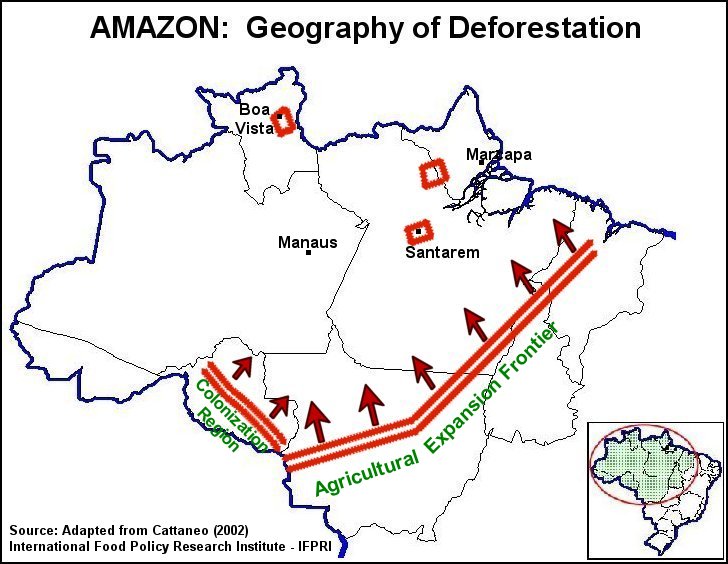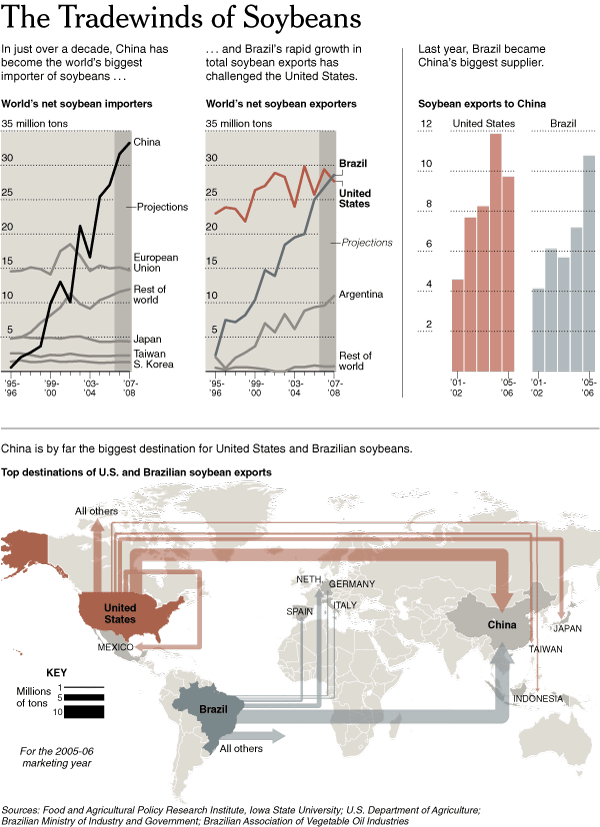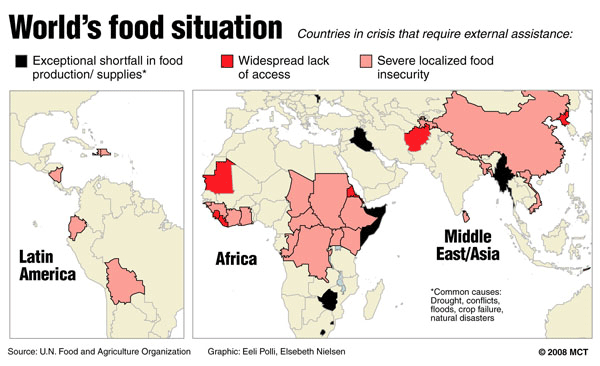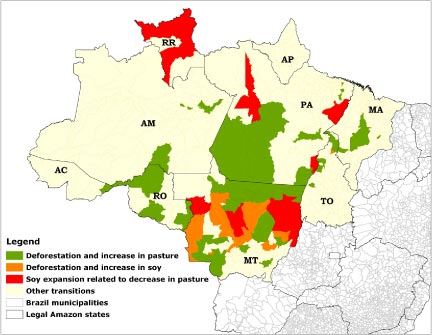Soybean Consumption in China Endangers Brazil’s Amazon Rainforest
posted on May 30th, 2011 in Amazon Jungle, Brazil, Environment
China’s Interest in Farmland Makes Brazil Uneasy
May 26, 2011
NYT
URUAÇU, Brazil — When the Chinese came looking for more soybeans here last year, they inquired about buying land — lots of it.
Officials in this farming area would not sell the hundreds of thousands of acres needed. Undeterred, the Chinese pursued a different strategy: providing credit to farmers and potentially tripling the soybeans grown here to feed chickens and hogs back in China…
“They need the soy more than anyone,” said Edimilson Santana, a farmer in the small town of Uruaçu. “This could be a new beginning for farmers here.”
The $7 billion agreement signed last month — to produce six million tons of soybeans a year — is one of several struck in recent weeks as China hurries to shore up its food security and offset its growing reliance on crops from the United States by pursuing vast tracts of Latin America’s agricultural heartland.
Even as Brazil, Argentina and other nations move to impose limits on farmland purchases by foreigners, the Chinese are seeking to more directly control production themselves, taking their nation’s fervor for agricultural self-sufficiency overseas.
“They are moving in,” said Carlo Lovatelli, president of the Brazilian Association of Vegetable Oil Industries. “They are looking for land, looking for reliable partners. But what they would like to do is run the show alone.”
While many welcome the investments, the aggressive push comes as Brazilian officials have begun questioning the “strategic partnership” with China encouraged by former President Luiz Inácio Lula da Silva. The Chinese have become so important to Brazil’s economy that it cannot do without them — and that is precisely what is making Brazil increasingly uneasy.
“One thing the world can be sure of: there is no going back,” Mr. da Silva said while visiting Beijing in 2009.
China has become Brazil’s biggest trading partner, buying ever increasing volumes of soybeans and iron ore, while investing billions in Brazil’s energy sector. The demand has helped fuel an economic boom here that has lifted more than 20 million Brazilians from extreme poverty and brought economic stability to a country accustomed to periodic crises.
Yet some experts say the partnership has devolved into a classic neo-colonial relationship in which China has the upper hand. Nearly 84 percent of Brazil’s exports to China last year were raw materials, up from 68 percent in 2000. But about 98 percent of China’s exports to Brazil are manufactured products — including the latest, low-priced cars for Brazil’s emerging middle class — that are beating down Brazil’s industrial sector.
“The relationship has been very unbalanced,” said Rubens Ricupero, a former Brazilian diplomat and finance minister. “There has been a clear lack of strategy on the Brazilian side.”
While visiting China last month, Brazil’s new president, Dilma Rousseff, emphasized the need to sell higher-value products to China, and she has edged closer to the United States. “It is not by accident that there is a sort of effort to revalue the relationship with the United States,” said Paulo Sotero, director of the Brazil Institute at the Woodrow Wilson International Center for Scholars. “China exposes Brazil’s vulnerabilities more than any other country in the world.”
China’s moves to buy land have made officials nervous. Last August, Luís Inácio Adams, Brazil’s attorney general, reinterpreted a 1971 law, making it significantly harder for foreigners to buy land in Brazil. Argentina’s president, Cristina Fernández de Kirchner, followed suit last month, sending a law to Congress limiting the size and concentration of rural land foreigners could own.
Mr. Adams said his decision was not a direct result of land-buying by China, but he noted that huge “land grabs” in Latin America and sub-Saharan Africa, including China’s attempt to lease about three million acres in the Philippines, had alarmed Brazilian officials.
“Nothing is preventing investment from happening, but it will be regulated,” Mr. Adams said.
A World Bank study last year said that volatile food prices had brought a “rising tide” of large-scale farmland purchases in developing nations, and that China was among a small group of countries making most of the purchases.
Foreigners own an estimated 11 percent of productive land in Argentina, according to the Argentine Agriculture Federation. In Brazil, one government study estimated that foreigners owned land equivalent to about 20 percent of São Paulo State.
International investors have criticized the restrictions. At least $15 billion in farming and forestry projects in Brazil have been suspended since the government’s limits, according to Agroconsult, a Brazilian agricultural consultancy.
“The tightening of land purchases by foreigners is really a step backwards into a Jurassic mentality of counterproductive nationalism,” said Charles Tang, president of the Brazil-China Chamber of Commerce, saying that American farmers had bought sizable plots in Brazil in recent years, with little uproar.
Responding to the criticism, Brazil’s agriculture minister said this month that Brazil might start leasing farmland to foreigners, given the barriers to ownership.
China itself does not allow private ownership of farmland, and it cautioned local governments against granting large-scale or long-term leases to companies in a 2001 directive. China also bans foreign companies from buying mines and oil fields.
But as more of its people eat meat, China is expected to increase its soybean imports, mostly for animal feed, by more than 50 percent by 2020, according to the United States Department of Agriculture. Last month, Chongqing Grains signed a $2.5 billion agreement to produce soybeans in the Brazilian state of Bahia. Last October, a Chinese group agreed to develop about 500,000 acres of farmland in Río Negro Province in Argentina.
Map of Brazilian Amazon with deforestation and soybean production patterns
In both cases, Chinese officials proposed buying large tracts of land before local officials steered them toward production agreements.
“We are never going to sell the land,” said Juan Manuel Accatino, the minister of production in Río Negro.
Brian Willott, an American farmer who came to Brazil in 2003, said Chinese interest in buying farms had not abated. “Everywhere you go to look at a farm they say, ‘We are considering selling to the Chinese,’ ” he said.
In Goiás State, nearly 70 percent of the soy grown went to the Chinese last year, and the Chinese are seeking to use about 20 million acres of pastureland that has not been cultivated for decades.
“For them, the faster the better,” said Antônio de Lima, Goiás’ agriculture minister.
Farmers here say they share Chinese officials’ goal of breaking the stranglehold of international trading companies like Cargill and Archer Daniels Midland.
But Tan Lin, a manager at the Chinese company involved in Goiás, said he doubted Chinese companies were ready to replace them.
“I don’t see that the Chinese companies working here have that expertise yet,” Mr. Tan said. But “if you can do that, it is good, of course.”




